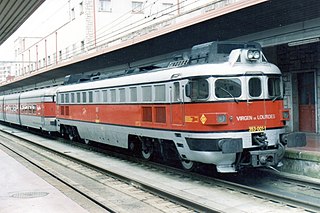
Talgo is a Spanish manufacturer of intercity, standard, and high-speed passenger trains. Talgo is an abbreviation of Tren Articulado Ligero Goicoechea Oriol

Alta Velocidad Española (AVE) is a high-speed rail service operated by Renfe, the Spanish State railway company.

The SNCF Class BB 9300 was a class of French 1500V DC electric locomotives built by Schneider-Jeumont/CEM between 1967 and 1969. They were later mainly used on passenger services around Marseille, Avignon, Nîmes, Narbonne and Toulouse, and all had been withdrawn by 2014.

Portbou is a town in the Alt Empordà county, in the Province of Girona, Catalonia, Spain. It has a population of 1077 people (2018).
Elipsos Internacional S.A. was a Spanish company which was set up in 2001 by Spanish RENFE and French SNCF with a 50% share each. It was created to handle the logistics of Trenhotel night railway services between Spain and France, Switzerland and Italy; in 2013 only services to France remained; they were cut back to thrice a week in September 2013, and discontinued on 15 December as the high speed line between France and Spain had opened. The Elipsos Trenhotel operated with Talgo gauge change trains.

The Renfe Class 353, formerly known as the T-3000 are a class of diesel-hydraulic locomotives built by Krauss-Maffei for express trains in Spain.

Rail transport in Catalonia operates on three rail gauges and services are operated by a variety of public operators:

Perpignan station is the railway station serving the city of Perpignan, Pyrénées-Orientales department, Occitanie, southern France. Part of the station was decorated in the style of Salvador Dalí, for whom the place held special significance, having proclaimed it to be the "Centre of the Universe" after experiencing a vision of cosmogonic ecstasy there in 1963 and made a painting called La Gare de Perpignan in 1965.

Narbonne is a railway station in Narbonne, Occitanie, France. The station opened on 22 April 1857 and is on the Bordeaux–Sète railway and Narbonne–Portbou railway lines. The station is served by TGV, Intercités and TER (local) services operated by the SNCF. The line was electrified through Narbonne in 1935.

The Portet-Saint-Simon - Puigcerdà railway is a secondary railway line in southwestern France. It connects Portet-sur-Garonne, 11 km south of Toulouse on the Toulouse–Bayonne railway, to Latour-de-Carol and Puigcerdà, towns located on each side of the French/Spanish border in Cerdanya. The railway was opened in several stages between 1861 and 1929.

Portbou is a railway station serving Portbou in Catalonia, Spain. It is on the Barcelona–Cerbère railway and the Narbonne–Portbou railway. The station is owned by Adif and is served by Rodalies de Catalunya regional line R11 and Girona commuter rail service line RG1 and TER Occitanie trains also serve the station.

Cerbère station is the railway station serving the border town Cerbère, Pyrénées-Orientales department, southern France.

The Narbonne—Portbou railway is an important 104-kilometre long railway line that connects the city of Narbonne, France to northeastern Spain. The railway was built by the Compagnie des Chemins de fer du Midi. The first section that was opened in 1858 led from Narbonne to Perpignan. The line was extended to the Spanish border town Portbou in 1878.

The Albert Schweitzer was a short-lived express train that linked Dortmund Hbf in Dortmund, Germany, with Strasbourg-Ville in Strasbourg, France. Introduced in 1980, it was operated by the Deutsche Bundesbahn (DB) and the SNCF.

The word Mediolanum has been used to name three distinct international express trains that have run to and from Milano Centrale in Milan, Italy since 1957. The focus of these trains on the city now known as Milan reflects the fact that Mediolanum is the Latin word for ancient Milan.

The Blauer Enzian is a named express train service that currently runs between Frankfurt in Germany and Klagenfurt in Austria. Introduced in 1951, it originally ran via the German North–South railway line between Hamburg and Munich. Labelled as an international Trans Europ Express (TEE) train, it also linked with Zell am See and Klagenfurt in Austria from 1969. Trains were operated by the Deutsche Bundesbahn (DB) and its Deutsche Bahn successor, from 1970 also by the Austrian Federal Railways (ÖBB).

The Ligure was an international express train operated by the Italian Railways linking Milan with the Côte d'Azur. The train was named after the Italian region Liguria which was served by the train.
The Lemano was an international express train linking Milan with Geneva. The train is named after Lake Geneva, the north shore of which was followed by the train over the lake's entire length. Introduced in 1958, it was a first-class-only Trans Europ Express service until 1982, and thereafter a two-class express train.

The Barcelona–Cerbère railway is a 168-kilometre (104.39 mi) railway line linking Barcelona in Catalonia, Spain to Cerbère in France. It is served by the Rodalies de Catalunya commuter network, Renfe regional, MD, AVE, Avlo and Avant train services, and TGV trains. The line stars at Barcelona Sants railway station, and passes through the Catalan regional cities of Girona and Figueres before reaching the French border, and then Cerbère, just across the border. It is an important commuter and High Speed line, connecting Paris, Montpellier and Perpinyà to Spain.

The R11 is a line of Rodalies de Catalunya's regional rail service, operated by Renfe Operadora. It runs northwards from the Barcelona area to the French border town of Cerbère, passing through the Vallès Oriental, Selva, Gironès and Alt Empordà regions. With a total line length of 172 kilometres (107 mi), it extends notably beyond the limits of the Barcelona metropolitan area, reaching the Pyrenees mountains.























